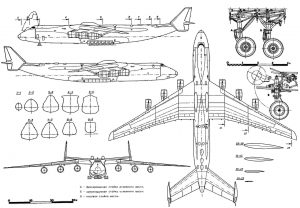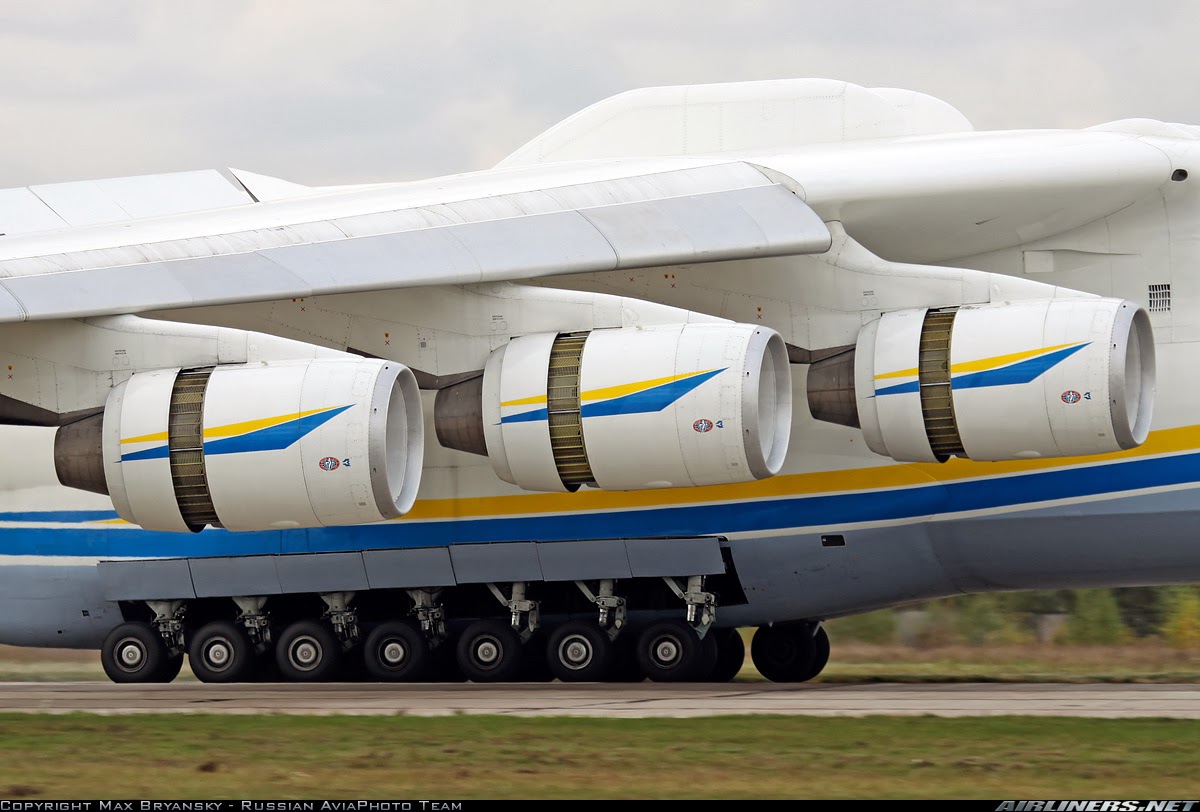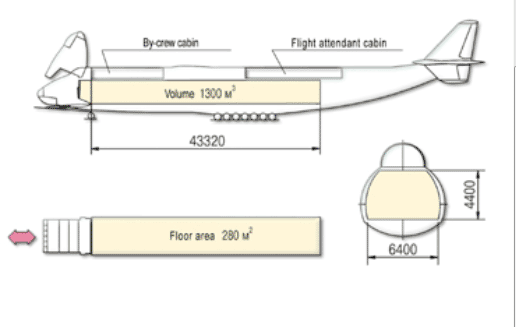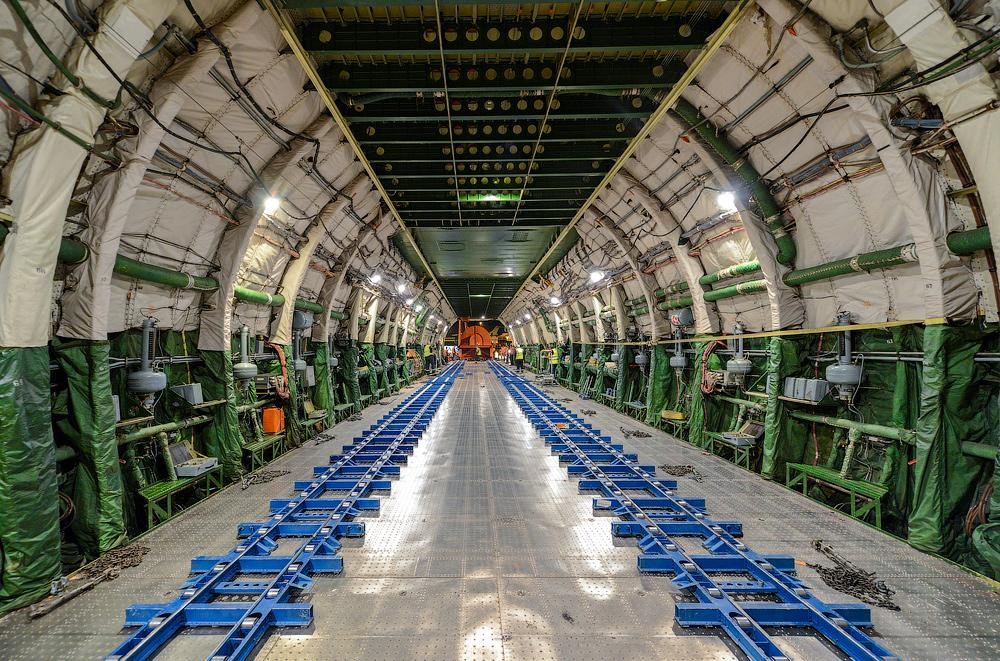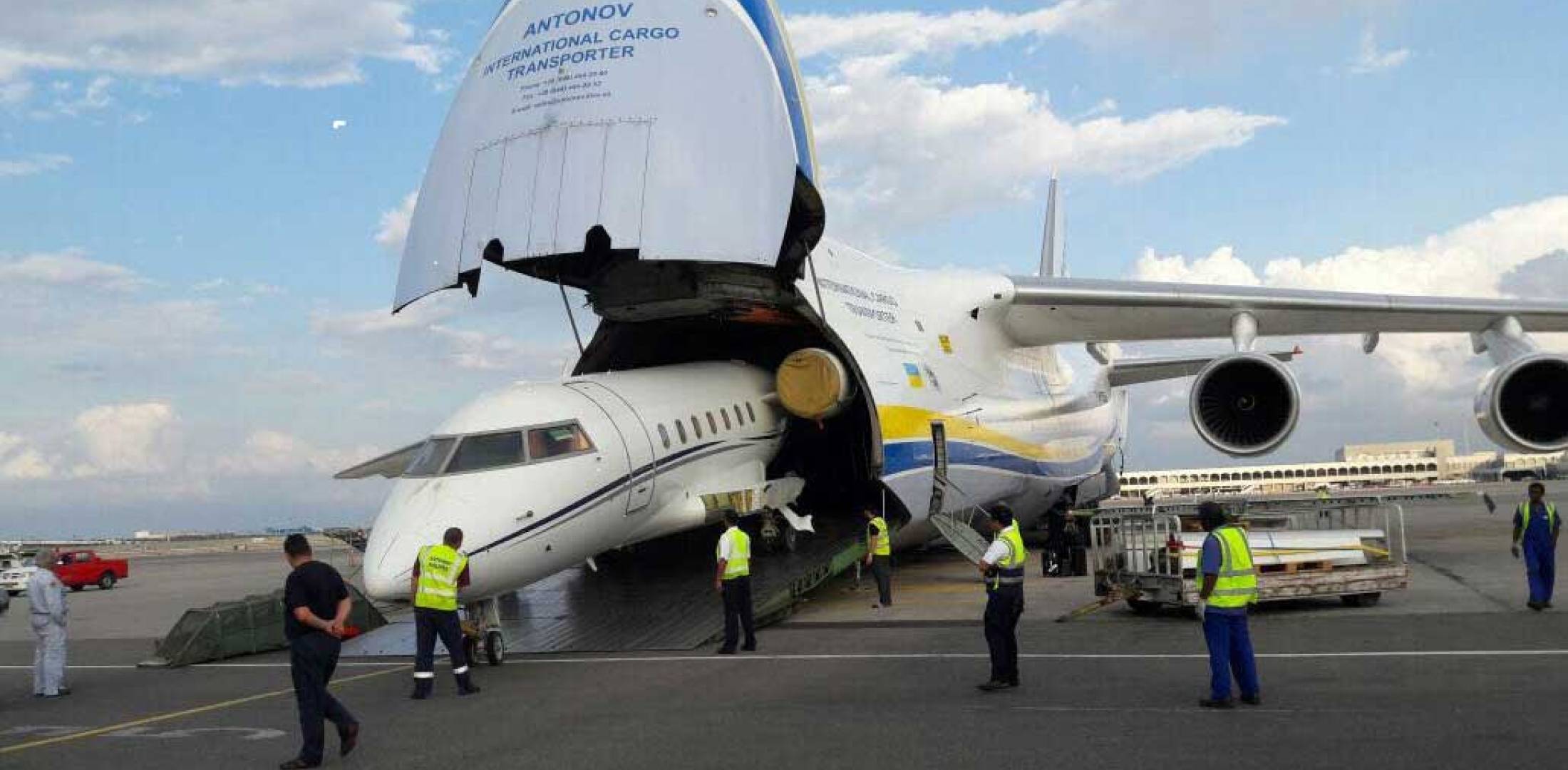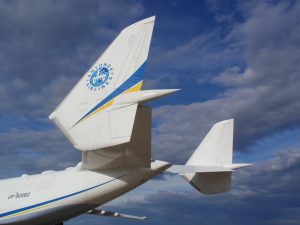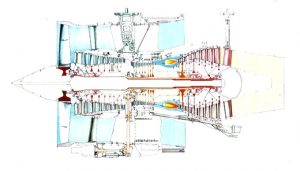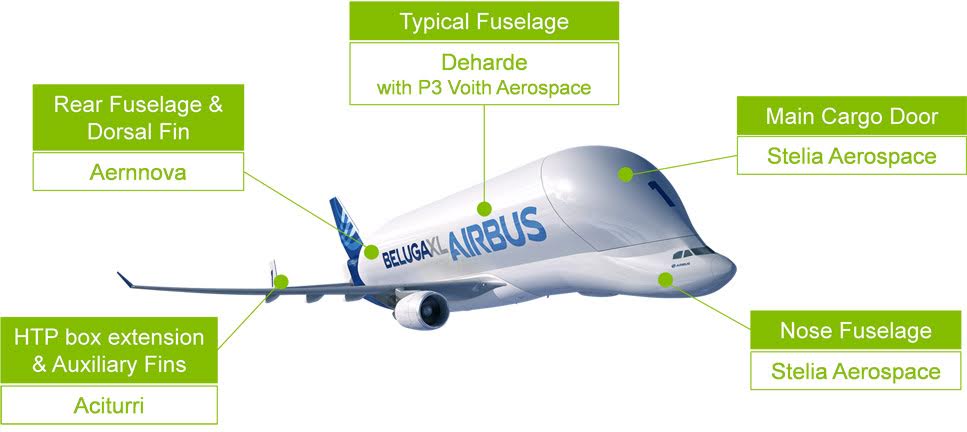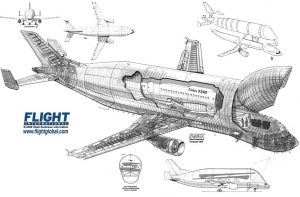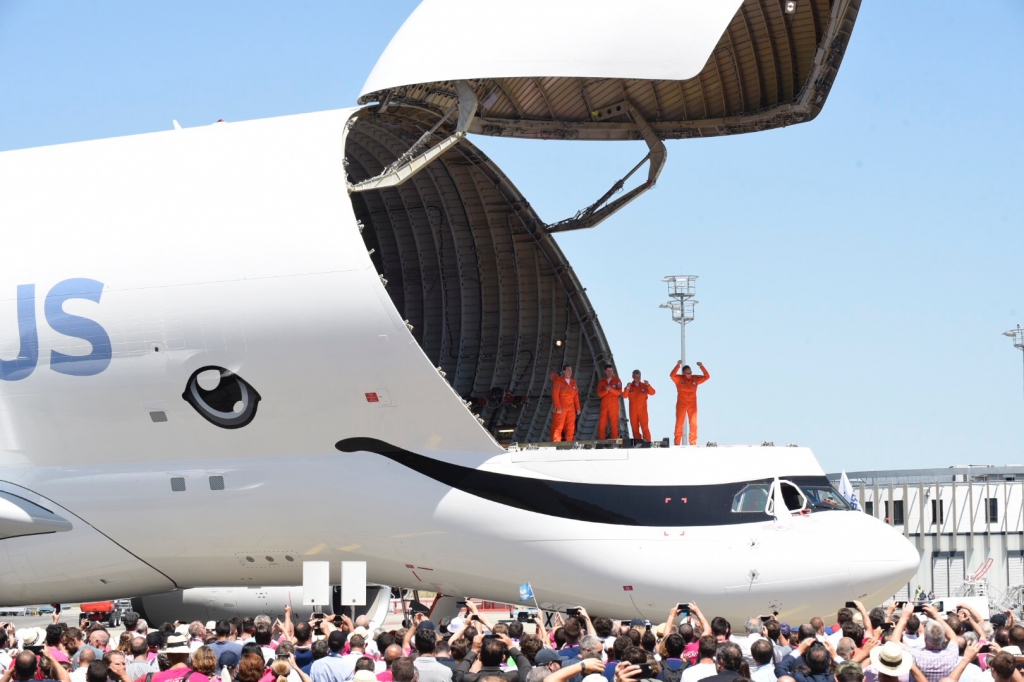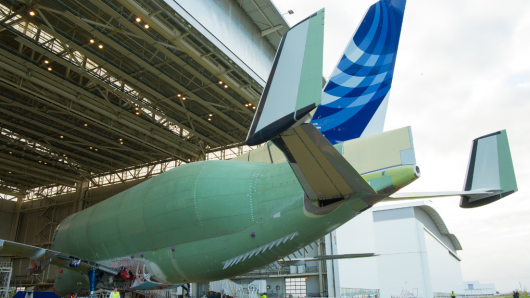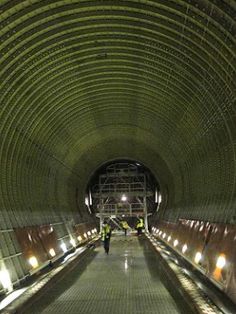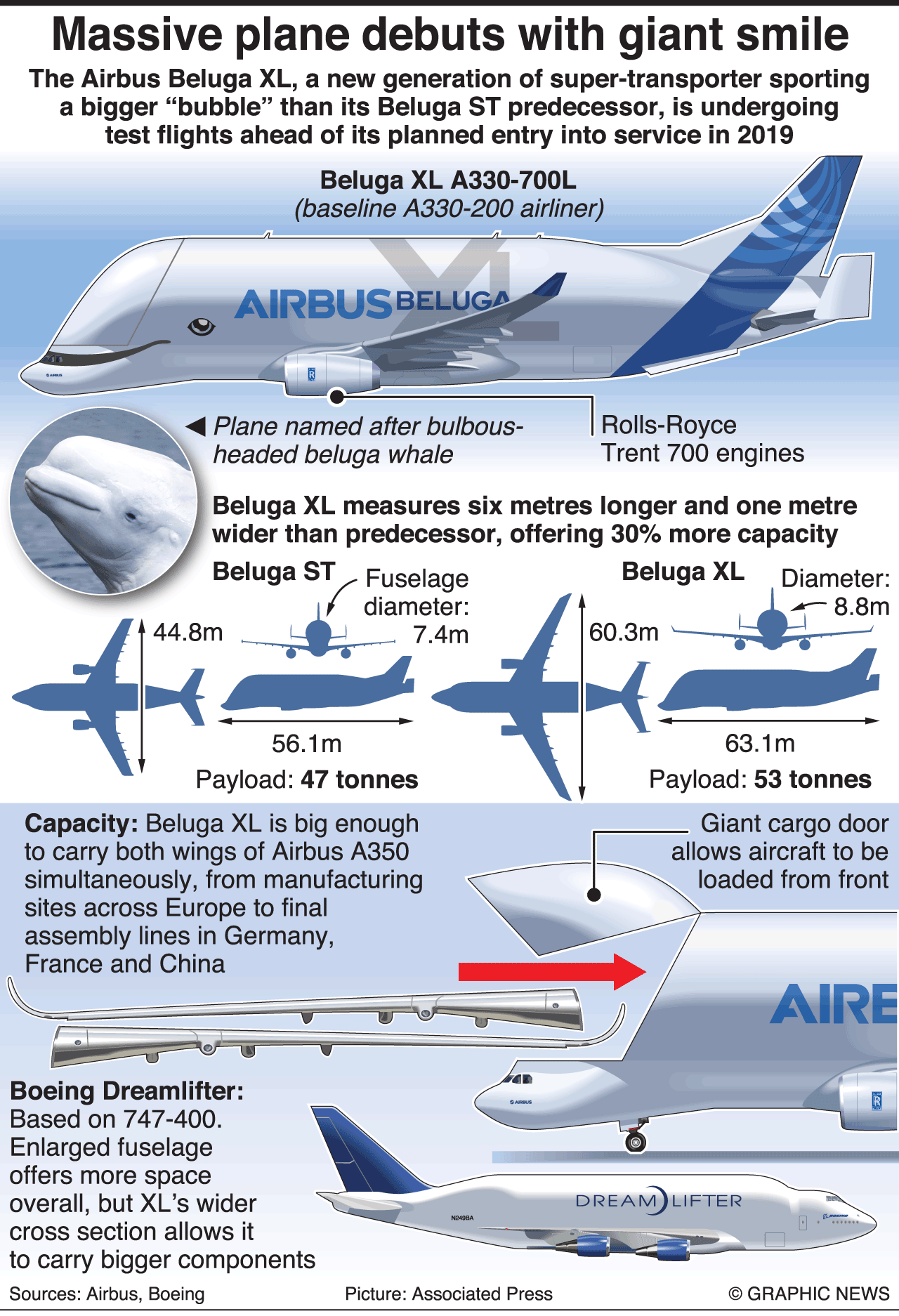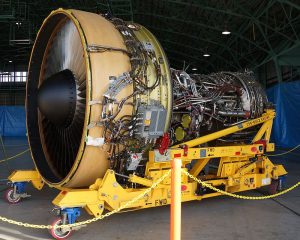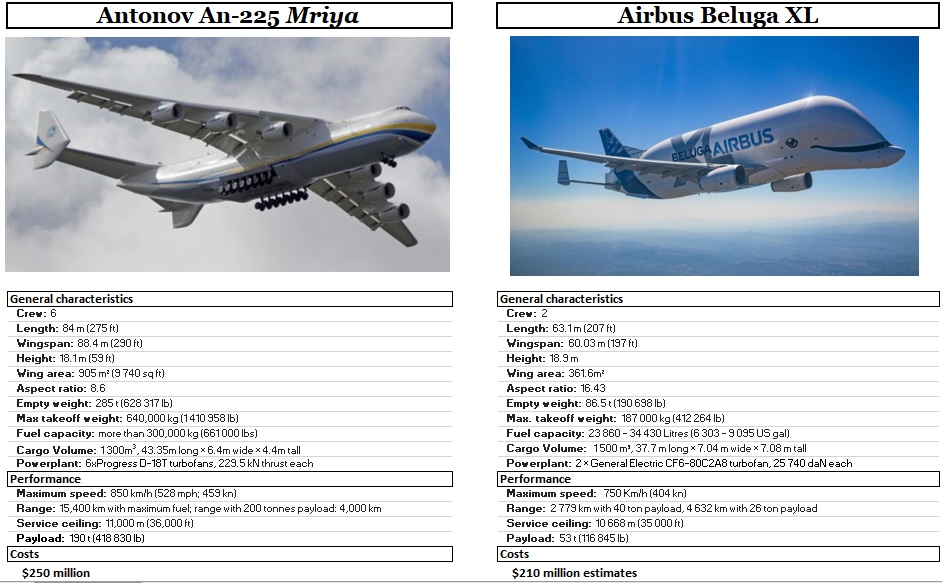
|
The Antonov An-225 Mriya is a strategic airlift cargo aircraft that was designed by the Antonov Design Bureau in the Ukrainian SSR within the Soviet Union during the 1980s. It is powered by six turbofanengines and is the heaviest aircraft ever built, with a maximum takeoff weight of 640 tonnes (710 short tons; 630 long tons). It also has the largest wingspan of any aircraft in operational service. The single example built has the Ukrainian civil registration UR-82060. A second airframe with a slightly different configuration was partially built. Its construction was halted in 1994 because of lack of funding and interest, but revived briefly in 2009, bringing it to 60–70% completion. On 30 August 2016, Antonov agreed to complete the second airframe for Aerospace Industry Corporation of China (not to be confused with the Aviation Industry Corporation of China) as a prelude to AICC commencing series production. The Antonov An-225, initially developed for the task of transporting the Buran spaceplane, was an enlargement of the successful Antonov An-124. The first and only An-225 was completed in 1988. After successfully fulfilling its Soviet military missions, it was mothballed for eight years. It was then refurbished and re-introduced, and is in commercial operation with Antonov Airlines carrying oversized payloads. The airlifter holds the absolute world records for an airlifted single-item payload of 189,980 kilograms (418,830 pounds), and an airlifted total payload of 253,820 kg (559,580 lb). Development The Antonov An-225 was designed to airlift the Energia rocket’s boosters and the Buran orbiter for the Soviet space program. It was developed as a replacement for the Myasishchev VM-T. The An-225’s original mission and objectives are almost identical to that of the United States’ Shuttle Carrier Aircraft. The An-225 first flew on 21 December 1988 with a 74-minute flight from Kiev. The aircraft was on static display at the Paris Air Show in 1989 and it flew during the public days at the Farnborough air show in 1990. Two aircraft were ordered, but only one An-225 was finished. It can carry ultra-heavy and oversize freight, up to 250,000 kg (550,000 lb) internally,or 200,000 kg (440,000 lb) on the upper fuselage. Cargo on the upper fuselage can be 70 m (230 ft) long. A second An-225 was partially built during the late 1980s for the Soviet space program. Following the collapse of the Soviet Union in 1991 and the cancellation of the Buran space program, the lone operational An-225 was placed in storage in 1994. The six Ivchenko-Progress engines were removed for use on An-124s, and the second uncompleted An-225 airframe was also stored. When it became clear that a cargoliner bigger than the An-124 was needed, the first An-225 was re-engined and put back into service. By 2000, the need for additional An-225 capacity had become apparent, so the decision was made in September 2006 to complete the second An-225. The second airframe was scheduled for completion around 2008, then delayed. By August 2009, the aircraft had not been completed and work had been abandoned. In May 2011, the Antonov CEO is reported to have said that the completion of a second An-225 Mriya transport aircraft with a carrying capacity of 250 tons requires at least $300 million, but if the financing is provided, its completion could be achieved in three years. According to different sources, the second aircraft is 60–70% complete. In April 2013, the Russian government announced plans to revive Soviet-era air launch projects that would use a purpose-built modification to the An-225 as a midair launchpad. In August 2016, representatives from Ukraine’s Antonov and Airspace Industry Corporation of China (AICC), an import-export company operating out of Hong Kong, signed an agreement to recommence production of the An-225, with China now planning to procure and fly the first model by 2019. The aviation media cast doubt on the production restart, indicating that due to the ongoing Russia–Ukraine conflict needed parts from Russia are unavailable, although they may be made in China instead. AICC’s president, Zhang You-Sheng, told a BBC reporter that AICC began to contemplate cooperation with Antonov in 2009 and contacted them in 2011. AICC intends to modernize the second unfinished An-225 and develop it into an air launch to orbit platform for commercial satellites at altitudes up to 12,000 m (39,370 ft). Design Based on Antonov’s earlier An-124, the An-225 has fuselage barrel extensions added fore and aft of the wings. The wings also received root extensions to increase span. Two more Progress D-18T turbofan engines were added to the new wing roots, bringing the total to six. An increased-capacity landing gear system with 32 wheels was designed, some of which are steerable, enabling the aircraft to turn within a 60 m-wide (200 ft) runway.
All about Antonov 225 Mriya Like its An-124 predecessor, the An-225 has nose gear designed to “kneel” so cargo can be more easily loaded and unloaded. Unlike the An-124, which has a rear cargo door and ramp, the An-225 design left these off to save weight, and the empennage design was changed from a single vertical stabilizer to a twin tail with an oversized, swept-back horizontal stabilizer. The twin tail was essential to enable the plane to carry large, heavy external loads that would disturb the airflow around a conventional tail. Unlike the An-124, the An-225 was not intended for tactical airlifting and is not designed for short-field operation. Initially the An-225 had a maximum gross weight of 600 t (660 short tons; 590 long tons), but from 2000 to 2001 the aircraft underwent modifications at a cost of US$20M such as the addition of a reinforced floor, which increased the maximum gross weight to 640 t (710 short tons; 630 long tons). Both the earlier and later takeoff weights establish the An-225 as the world’s heaviest aircraft, being heavier than the double-deck Airbus A380. It is surpassed in other size-related categories, however: Airbus claims to have improved upon the An-225’s maximum landing weight by landing an A380 at 591.7 tonnes (1,304,000 lb) during tests, and the Hughes H-4 Hercules, known as the “Spruce Goose”, has a greater wingspan and a greater overall height. But the Spruce Goose is 20% shorter and overall lighter, due to the materials used in its construction. In addition, the H-4 only flew once, making the An-225 the largest aircraft in the world to fly multiple times. The An-225’s pressurized cargo hold is 1,300 m3 (46,000 cu ft) in volume; 6.4 m (21 ft 0 in) wide, 4.4 m (14 ft) high, and 43.35 m (142 ft 3 in) long— longer than the first flight of the Wright Flyer. Engines Three of six Ivchenko Progress D-18T turbofan engines on the An-225. The D-18T was developed by the Ukrainian company Sich, Zaporozhye Motor Sich was founded in 1907 and acquired a big knowledge about the creation of motor’s plane.
|
The Airbus Beluga XL (Airbus A330-743L) is a large transport aircraft due to enter into service in 2019. It is based on the A330 airliner, to be the successor to the Airbus Beluga. The XL has an extension on the fuselage top like the Beluga. It is being designed, built and will be operated by Airbus to move oversized aircraft components. The aircraft made its first flight on 19 July 2018.
Development In 2013 the five original Belugas could not cope with production growth and Airbus evaluated the Antonov An-124 and An-225, Boeing C-17 or Dreamlifter, and A400M before choosing to modify one of its own. The program was launched in November 2014 to build five aircraft to replace the existing five Belugas, the design freeze was announced on 16 September 2015.
Fleet The existing Belugas will not be withdrawn from service when the Beluga XL is introduced; a mixed fleet is to operate for at least five years as the increased production rate of single-aisle aircraft requires the ability to move more parts. The current Beluga fleet flew more than 8000 hours in 2017, doubled from 2014, but the five Beluga fleet is only at its half-life: another operator could use them for civil or military logistic applications. The Beluga fleet will rise to eight when three XLs will be delivered as the five originals stay in service before being withdrawn from 2021. The original Beluga fleet is reaching its limits, flying five times daily and six days per week: 10,000h in 2017 while some parts move on the surface. An original Beluga takes triple the time to move the A330 parts compared to the parts of an A320, climbing to nine times for the A350 parts. As of 19 July 2018 there is only one Beluga XL, F-WBXL, although a second aircraft is in production.
Production The aircraft’s lower fuselage will be assembled on the A330 final assembly line, and then be moved to another facility for the year-long process of assembling the upper fuselage and the lowered nose fuselage. The first section arrived in Toulouse in November 2016. Final assembly started on 8 December 2016. The first large sections: one central and two lateral rear section panels, arrived on 12 April 2017 at the Toulouse Final Assembly facility (L34) from Aernnova’s factory in Berantevilla, Spain. Constructed by Stelia Aerospace in Meaulte, its 12×4m, 8.2t nose section was delivered in May 2017. The 9 m wide, 8 m long and high, 2.1 t upper front fuselage part, framing the cargo door, was delivered from Stelia Rochefort on 7 July 2017. The 3.1t, 10m long and 8m high door was delivered by Stelia Rochefort in September 2017. In October 2017, 75% of the first BelugaXL structural assembly was done with systems, mechanical and electrical integration underway before tail elements, already received, are integrated. Its maiden flight is scheduled for summer 2018 before 10 months of flight tests necessary for its certification campaign and a 2019 service entry. The second aircraft will enter final assembly line in December 2018 and the three remaining each following year.
After mating the vertical fin, tail cone and horizontal stabiliser including the outboard vertical surfaces, the main freight door will be attached from mid-November before power-on at the end of 2017. The flight test campaign will use a single, instrumented aircraft. The front cargo door was attached in December 2017. In January 2018, the second arrived in Toulouse for its transformation, in two months less after lessons learned from the first.
Design The first BelugaXL rolled out of the assembly line on 4 January 2018, unpainted and with no engines. Fewer than 1,000 flight test hours are planned for its certification campaign. After fitting its engines, it will be ground tested for months to assess its systems operation, while bench tests in Toulouse and Hamburg, on flight simulators and in laboratories, simulate flight loads on full-scale copies of specific joints between the upper bubble and the lower fuselage, clearing the aircraft for flight then type certification.
In March 2018, the first (MSN1824) was having its engines fitted while the second (MSN1853) was 30% converted. After successful landing-gear and flight-control system checks, MSN1824 will be fuel and ground tested. The third will begin its conversion before the end of 2018. MSN1853 will be first operational in 2019 after proving work in 11 European stations, while MSN1824 flight instrumentation will be disassembled. It was rolled out with its engines but no winglets in April 2018.
It passed the Ground Vibration Test in early June 2018, with ONERA and DLR measuring its dynamic behaviour compared to flight envelope theoretical models. The flight-test programme should last 600h. The second plane had its lower fuselage completed by mid-June before upper shell structural work and freight door fitting after summer for a completion by September or October. The first flight was on 19 July 2018. With 30% more capacity than the existing Beluga, it will be able to carry two A350 XWB wings instead of one. Its new fuselage is 6.9 m longer and 1.7 metre wider than the Beluga, and it will be able to lift a payload 6 tons heavier. Its aft section is based on the A330-300 while its forward on the A330-200 for centre of gravityreasons, and the reinforced floor and structure comes from the -200F. The A330 wings, main landing-gear, central and aft fuselage form a semi-built platform with few systems, without the aft upper fuselage while the upper central fuselage is cut off, facilitated by the metal construction. The enlarged freight hold is mounted in three months with 8,000 new parts on the junction line.
The unpressurised hold begins with the tail adapted by Spain’s Aernnova and continues by building the upper fuselage with two side panels and a crown for each section, for a maximum diameter of 8.8m. Produced by Stelia Aerospace, its main freight door has 24 latches and the nose includes the cockpit while a four-seat courier section is supplied by Airbus. Its vertical stabiliser is 50% larger, it has auxiliary fins on the horizontal stabiliser and two ventral fins beneath the empennage. It will operate at M0.69 up to 35,000ft over 2,300 nmi instead of the original 900 nmi. Deharde Aerospace and the P3 group provide the upper fuselage while Aciturri produces the horizontal tail plane extension, auxiliary and ventral fins.
Engines The General Electric CF6 is a family of high-bypass turbofan engines produced by GE Aviation. Based on the TF39, the first high-power high-bypass jet engine, the CF6 powers a wide variety of civilian airliners. The basic engine core also powers the LM2500, LM5000, and LM6000 marine and power generation turboshafts. The newer GEnx family has been introduced, intended to replace the CF6 family.
For the CF6-80C2-A1, the fan diameter is increased to 93 in (2.36 m), with an airflow of 1750 lb/s (790 kg/s). Overall pressure ratio is 30.4, with a bypass ratio of 5.15. Static thrust is 59,000 lb (263 kN). An extra stage is added to the LP compressor, and a 5th to the LP turbine.[4] The CF6-80C2 is currently certified on eleven widebody aircraft models including the Boeing 747-400, and McDonnell Douglas MD-11. The CF6-80C2 is also certified for ETOPS-180 for the Airbus A300, Airbus A310, Boeing 767, Kawasaki C-2, and, as the F138, the Lockheed C-5M Super Galaxy.
|

